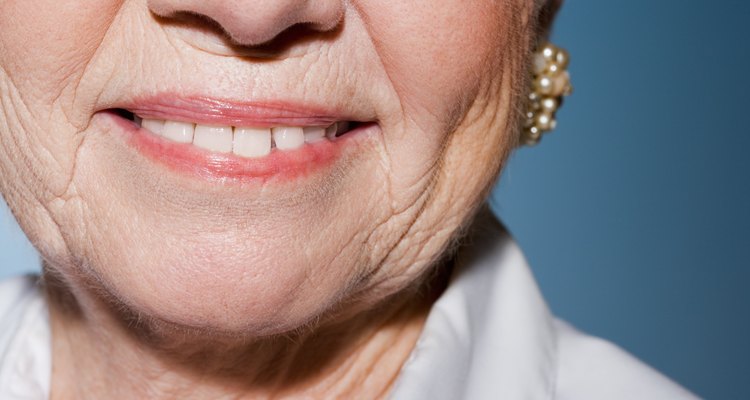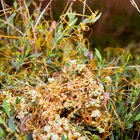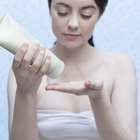
Image Source Pink/Image Source/Getty Images
Palmitoyl oligopeptide, or Pal-GHK, is one of many peptides thought to improve damaged or aging skin. It is the shortest of a large group of palmitoyl peptides or oligopeptides with novel properties, and it is an ingredient in a variety of skin care products and cosmetics. Many palmitoyl peptides have similar effects on skin, and often skin care products contain more than one kind of palmitoyl peptide. Some blogs and online skin care content may create confusion by calling using the term "palmitoyl oligopeptides" for palmitoyl peptides other than Pal-GHK.
Palmitoyl Oligopeptide Structure
Palmitoyl oligopeptide, or Pal-GHK, is a short peptide coupled to palmitic acid. Peptides are short stretches of amino acids, whereas long stretches or more complicated chains of amino acids are referred to as proteins. When proteins degrade or are destroyed, the short protein pieces that are generated are called peptides. Palmitoyl oligopeptide is a peptide consisting of the amino acids glycine, histidine and lysine. The attachment of palmitic acid, a fatty acid, to the peptide helps it to penetrate the skin between the epidermis, the outer skin layer, and the dermis or lower skin layer.
Skin Repair Rationale
Skin consists of an outer layer, the epidemis, and a lower layer, the dermis, which maintains the skin's structure with a network of protein fibers made up of collagen and elastin. Wrinkles are caused by environmental factors and aging. As skin ages, it produces less collagen and the existing collagen in the skin is more rapidly degraded due to increased proteolytic activity by local enzymes. Cells, called fibroblasts, grow and multiply less and produce less collagen in aging skin than do fibroblasts in young skin. Some degraded collagen protein fragments stimulate synthesis of new collagen. Palmitoyl oligopeptide resembles one of these collagen fragments.
Supportive Studies
Early laboratory studies showed that palmitoyl oligopeptide can stimulate fibroblast cells to produce collagen, elastin and hyaluronic acid. Collagen and elastin are structural components of the dermis, and hyaluronic acid can hold large amounts of water and help plump up skin. Laboratory studies don't always translate into effective treatments in living organisms or people. However, when palmitoyl oligopeptide was applied to human female volunteers for four weeks, skin thickness increased significantly. Preparations containing palmitoyl oligopeptide and palmitoyl tetrapeptide-7 also produced a significant decrease in deep wrinkles and skin roughness, and it increased skin elasticity after 56 days.
Palmitoyl Oligopeptide Safety
Retinol creams are effective standard treatments for sun-damaged or aging skin. Although effective against wrinkles, retinol often causes redness, skin irritation and skin sensitivity to light. Palmitoyl oligopeptide can reduce wrinkles to a similar extent without the side effects of retinol. Both retinol and palmitoyl can preserve and renew collagen in skin damaged by ultraviolet light. Therefore, products containing palmitoyl oligopeptide may also protect users' skin from UV light.
Related Articles

Elastin Supplements

Skin Care Products That Contain ...

Collagen & Rosacea

What Are the Dangers of Fraxel Repair?

Traditional Uses of Cuscuta

The Role of Collagen & Melanin in Skin

List of Retinoids

Bromelain & Bruising

Estrogen in Skin Creams

What Foods Provide Calcium D-Glucarate?

How to Reduce Acne Inflammation

Definition of Skin Bleaching

Fraxel Repair Vs. Restore Results

Amino Acids to Get Rid of Acne Scars & ...

Homeopathy Cure for Stretch Marks

Glucosamine: Skin Benefits

Active Ingredients in Face Creams

Fraxel Laser Treatment Dangers

Can I Mix Vitamin C and Copper Peptides?

How to Keep Intimacy Alive in a ...
References
Writer Bio
Based in Connecticut, Marie-Luise Blue writes a local gardening column and has been published in "Organic Gardening" and "Back Home." Blue has a Ph.D. in biological sciences from the State University of New York at Stony Brook and wrote scientific articles for almost 20 years before starting to write gardening articles in 2004.
Photo Credits
Image Source Pink/Image Source/Getty Images